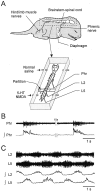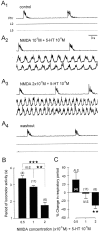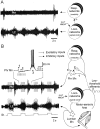Coordinations of locomotor and respiratory rhythms in vitro are critically dependent on hindlimb sensory inputs
- PMID: 12040083
- PMCID: PMC6758812
- DOI: 10.1523/JNEUROSCI.22-11-04756.2002
Coordinations of locomotor and respiratory rhythms in vitro are critically dependent on hindlimb sensory inputs
Abstract
A 1:1 coordination between locomotor and respiratory movements has been described in various mammalian species during fast locomotion, and several mechanisms underlying such interactions have been proposed. Here we use an isolated brainstem-spinal cord preparation of the neonatal rat to determine the origin of this coupling, which could derive either from a direct interaction between the central locomotor- and respiratory-generating networks themselves or from an indirect influence via a peripheral mechanism. We demonstrate that during fictive locomotion induced by pharmacological activation of the lumbar locomotor generators, a concomitant increase in spontaneous respiratory rate occurs without any evident form of phase coupling. In contrast, respiratory motor activity can be fully entrained (1:1 coupling) over a range of periodic electrical stimulation applied to low-threshold sensory pathways originating from hindlimb muscles. Our results provide strong support for the existence of pathways between lumbar proprioceptive afferents, medullary respiratory networks, and phrenic motoneurons that could provide the basis of the locomotor-respiratory coupling in many animals. Thus a peripheral sensory system involved in a well defined rhythmic motor function can be responsible for the tight functional interaction between two otherwise independent motor behaviors.
Figures







Similar articles
-
Spinal and pontine relay pathways mediating respiratory rhythm entrainment by limb proprioceptive inputs in the neonatal rat.J Neurosci. 2012 Aug 22;32(34):11841-53. doi: 10.1523/JNEUROSCI.0360-12.2012. J Neurosci. 2012. PMID: 22915125 Free PMC article.
-
Bimodal Respiratory-Locomotor Neurons in the Neonatal Rat Spinal Cord.J Neurosci. 2016 Jan 20;36(3):926-37. doi: 10.1523/JNEUROSCI.1825-15.2016. J Neurosci. 2016. PMID: 26791221 Free PMC article.
-
Intercostal and abdominal respiratory motoneurons in the neonatal rat spinal cord: spatiotemporal organization and responses to limb afferent stimulation.J Neurophysiol. 2008 May;99(5):2626-40. doi: 10.1152/jn.01298.2007. Epub 2008 Mar 12. J Neurophysiol. 2008. PMID: 18337363
-
Chapter 2--the spinal generation of phases and cycle duration.Prog Brain Res. 2011;188:15-29. doi: 10.1016/B978-0-444-53825-3.00007-3. Prog Brain Res. 2011. PMID: 21333800 Review.
-
Central pattern generators of the mammalian spinal cord.Neuroscientist. 2012 Feb;18(1):56-69. doi: 10.1177/1073858410396101. Epub 2011 Apr 25. Neuroscientist. 2012. PMID: 21518815 Review.
Cited by
-
Specific neural substrate linking respiration to locomotion.Proc Natl Acad Sci U S A. 2012 Jan 10;109(2):E84-92. doi: 10.1073/pnas.1113002109. Epub 2011 Dec 12. Proc Natl Acad Sci U S A. 2012. PMID: 22160700 Free PMC article.
-
Are type III-IV muscle afferents required for a normal steady-state exercise hyperpnoea in humans?J Physiol. 2014 Feb 1;592(3):463-74. doi: 10.1113/jphysiol.2013.261925. Epub 2013 Sep 2. J Physiol. 2014. PMID: 24000177 Free PMC article. Review.
-
Passive limb training modulates respiratory rhythmic bursts.Sci Rep. 2023 May 4;13(1):7226. doi: 10.1038/s41598-023-34422-2. Sci Rep. 2023. PMID: 37142670 Free PMC article.
-
State-dependent presynaptic inhibition regulates central pattern generator feedback to descending inputs.J Neurosci. 2008 Sep 17;28(38):9564-74. doi: 10.1523/JNEUROSCI.3011-08.2008. J Neurosci. 2008. PMID: 18799688 Free PMC article.
-
Modulation of spontaneous locomotor and respiratory drives to hindlimb motoneurons temporally related to sympathetic drives as revealed by Mayer waves.Front Neural Circuits. 2015 Feb 10;9:1. doi: 10.3389/fncir.2015.00001. eCollection 2015. Front Neural Circuits. 2015. PMID: 25713515 Free PMC article.
References
-
- Ballion B, Morin D, Viala D. Forelimb locomotor generators and quadrupedal locomotion in the neonatal rat. Eur J Neurosci. 2001;14:1727–1738. - PubMed
-
- Banzett RB, Mead J, Reid MB, Topulos GP. Locomotion in men has no appreciable mechanical effect on breathing. J Appl Physiol. 1992;72:1922–1926. - PubMed
-
- Bracci E, Beato M, Nistri A. Afferent inputs modulate the activity of a rhythmic burst generator in the rat disinhibited spinal cord in vitro. J Neurophysiol. 1997;77:3157–3167. - PubMed
Publication types
MeSH terms
LinkOut - more resources
Full Text Sources
Other Literature Sources
